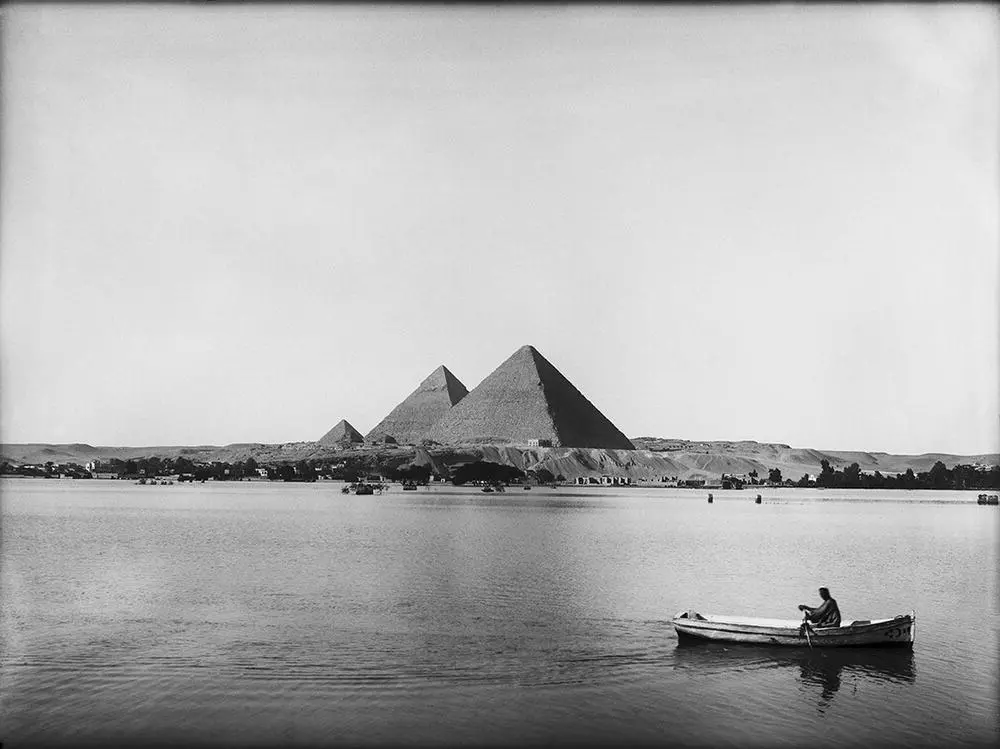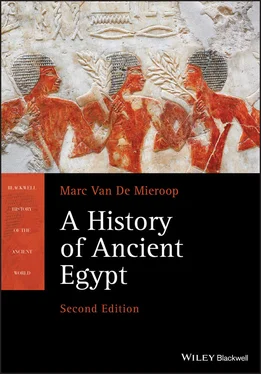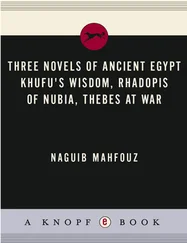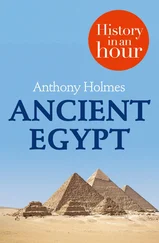North of Cairo, the river’s course is radically different. No longer enclosed by cliffs, it spreads out into a huge triangle, which we call the Delta, with multiple branches. Because of its location downstream, the region is called Lower Egypt, bordering the Mediterranean Sea. The eastern‐ and western‐most points of the Delta are 150 miles (250 kilometers) apart, and the shortest distance between Cairo and the sea is 100 miles (160 kilometers).
All agricultural land in Egypt is made up of silt that the river annually deposited during its flood, before the building of the High Aswan Dam. The river’s water derives from three main sources. The White Nile, which originates in Central Africa, is most constant in its flow and does not carry much silt. But two tributary rivers, the Blue Nile and the Atbara that stem from the Ethiopian highlands, bring a sudden influx of water from heavy summer rains and both carry lots of silt. In Egypt the Nile is at its lowest level in the months of May and June and starts to rise in July because of rain in Ethiopia. It reaches its highest point in mid‐September and recedes by mid‐October ( Figure 1.5). Its timing is in perfect harmony with the agricultural cycle, which makes farming in Egypt much less complex than in nearby regions and almost always guarantees that the population’s needs are satisfied.

Figure 1.5 Before the building of the Aswan dams the height of the Nile River’s flooding was of great importance as it determined how much agricultural land received water. At times the flood was so high, however, that its inundation caused destruction. The photograph here shows the Nile in flood near the Giza pyramids on October 31, 1927. Photograph by Mohammedani Ibrahim, Harvard University – Boston Museum of Fine Arts Expedition. Photograph © 2010 Museum of Fine Arts, Boston.
Source: Giza Archives
At one point in Upper Egypt the river water escapes the valley to flow into a large natural depression to its west, the Fayyum. From early prehistory on, the accumulated water allowed for farming along the edges, and starting in the early 2nd millennium BC, state initiatives tried to extend the agricultural zone by diverting the water into canals and controlling its flow. In the Ptolemaic and Roman periods these projects were very successful, and the Fayyum became the breadbasket for Egypt and beyond.
The areas outside the reach of the Nile flood are arid desert. West of the Nile stretches out the Sahara, mostly uninhabitable but for its northern fringe along the Mediterranean Sea. In the vast desert plateau are some depressions where underground water surfaces to form oases (through Greek and Latin the English term probably derives from the ancient Egyptian word ouhat ). Up to 250 miles (400 kilometers) west of the valley they constitute places that the Egyptians controlled and settled, sometimes with penal colonies. Routes between the oases made it possible to travel from north to south avoiding the Nile Valley. The eastern desert is much less extensive as it borders the Red Sea some 60 to 200 miles (95 to 320 kilometers) east of the Nile. In Egypt its northern part is a hilly plateau, while the southern part contains high mountains that are difficult to cross. Dry riverbeds, wadis in Arabic, cut through these mountains, however, and make travel from the Nile to the Red Sea possible, although water is in short supply from wells only.
Under current climatic conditions, the eastern and western deserts cannot support any farming and even the nomadic herding of animals is difficult. The eastern desert was a source of metals, including gold, and hard stones, however, and thus of great interest to the Egyptians. East of the Delta the eastern desert leads into Asia, across the modern Suez Canal. The Sinai desert to its east is mostly very inhospitable, and some parts of it contain high desolate mountains. Travel through Sinai is limited to routes along the Mediterranean coast. The region contains some very desirable resources, such as copper and the semi‐precious turquoise stone. Although Sinai formed a buffer between Egypt and Asiatic states, it was always in Egypt’s orbit.
With its location just north of the Tropic of Cancer, Egypt is hot, especially in the summer, when average temperatures in Aswan easily reach 40° Celsius. The country also receives very little rain and none of it in the summer. The current conditions did not always exist, however. Before the late 3rd millennium BC, the climate was wetter and enabled people to live outside the valley collecting wild resources and doing some farming. The environment of Egypt in prehistory and early history was thus different from that in the later historical period, and for the earliest developments scholars have to look beyond the valley to understand what went on.
Climate change and its effect on people all over the world is a very prominent concern today, and, not surprisingly, climatologists and historians are exploring evidence of it in the past. Because Egypt is fully dependent on the Nile River for its agriculture, decreases in the amount of rainfall in Africa have great consequences there, and historians have started to use climate change as an explanation for the ups and downs of the ancient Egyptian state. Others remain skeptical, not denying that there were variations in the climate, but questioning the impact on the political situation. Did the Old Kingdom end because of a decrease of Nile floods, for example (Key Debate 4.1)? Obviously, natural conditions were very important to the ancient Egyptians, and the climate was a major factor in those. Using climate change as the sole explanation seems to be a mistake, but we should indeed take it into account.
Hemmed in by deserts and the sea, Egypt has a degree of isolation many other countries lack. In the west, access is mainly restricted to a narrow strip along the coast; in the east, the high desert separates it from the Red Sea coast. The Mediterranean coast was also a frontier, and no harbor is known on it before the 1st millennium BC. Previously, boats had to sail inland before they could anchor. The 1st cataract delineated Egypt’s southern border on the Nile. Traffic in and out of the country was thus easy to control, and from early on kings established border posts at the 1st cataract and on the eastern and western points of the Delta to monitor it.
On the other hand, by its very location, Egypt was at a crossroads. Any overland movement between Africa and Asia had to pass through it. Thus early hominids from Africa crossed Egypt during their migration across the globe, while in the Middle Ages and later Egypt was the bridge between the heartland of the Middle Eastern empires and their North African possessions. Through the Mediterranean, Egypt was connected by sea to Southern Europe. In the late 2nd millennium BC, ships sailing along the eastern Mediterranean coast went from Egypt to Greece and the Aegean islands passing by the Syrian coast. In later times, overseas traffic between Egypt and Europe was intense, with huge cargo ships securing Rome’s grain supply. The Red Sea, reached through valleys in the eastern desert, gave access to regions of east Africa, the Middle East, and farther east. Such contacts are especially well attested in the Ptolemaic and Roman periods, but recent explorations of harbors on the Red Sea coast have shown that they did not start then. The ancient Egyptians liked to portray themselves as separate from the rest of the world, with a long local pedigree and immune from outside interference, but that was a false image. Throughout its history Egypt was exposed to external influences as foreigners were drawn to the country. The longevity of ancient Egyptian culture was partly due to the readiness of others to absorb it.
Читать дальше













